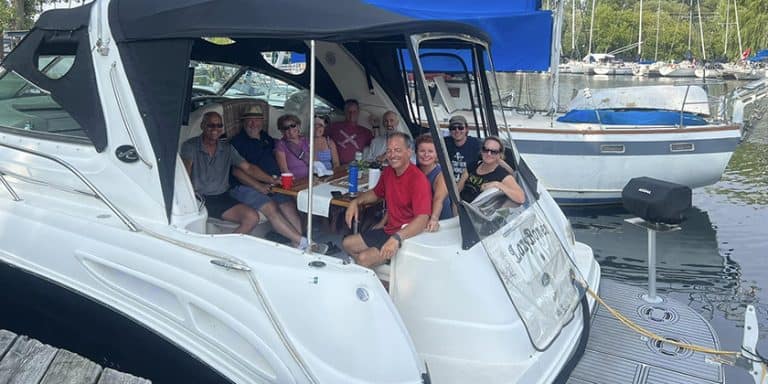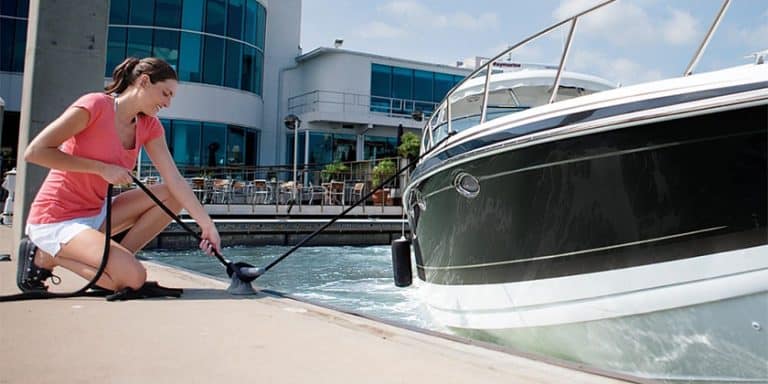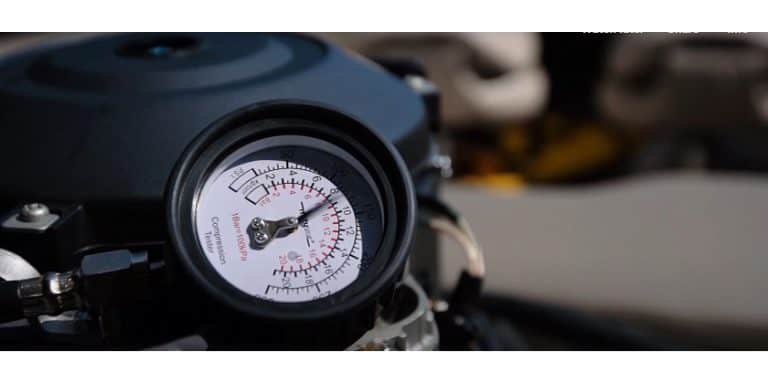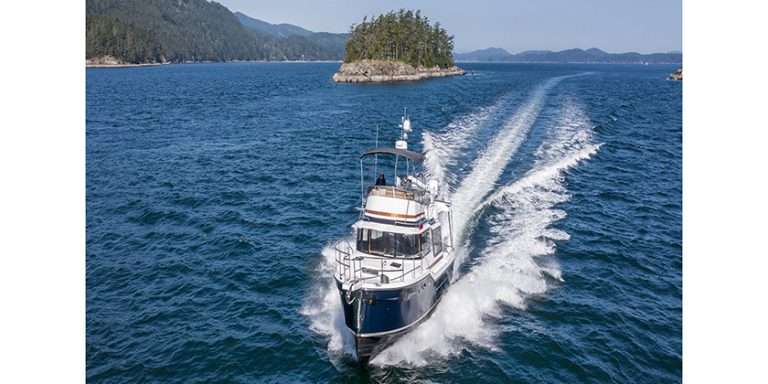Raft-up!
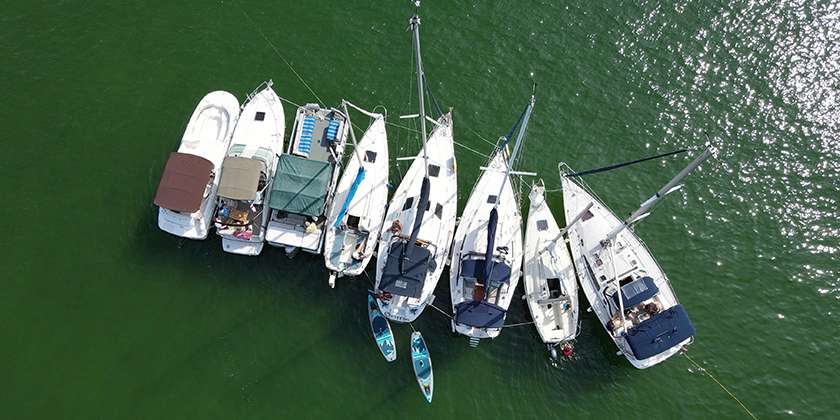
By Sheryl Shard
On calm sunny days on the water, you will often see boats rafted together at anchor, their crews enjoying the day and each other’s company, sharing a meal, swimming off the sterns or playing with water toys around the boats in the raft.
Most often the raft will consist of just two to three boats with friends and families aboard meeting up to socialize, but occasionally you’ll see a larger number of boats rafted together for a special occasion, such as at the annual raft-up party hosted by our local yacht club on Lake Simcoe in Ontario each summer. Depending on the year and conditions, there can be anywhere from five to fifteen boats participating, both power and sail. It’s a day we all look forward to and the afternoon is spent hopping from boat to boat sharing appetizers, swapping stories and clowning around in the water.
The world’s record for most recreational boats to tie together in a continuous single structure is 1,651 boats of all sizes as witnessed by representatives of Guinness World Records on Lake Cumberland, Kentucky, USA on August 14, 2010. The event was organized by the Lake Cumberland Association and eligible boats included any motorized boat, aqua bike/jetski, canoe/kayak and rigid inflatable boat tied together in a single continuous structure. Now that would be a party!
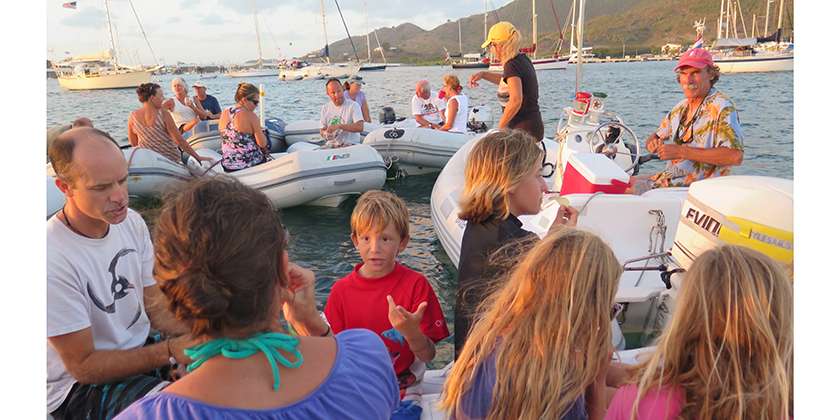
Dinghy raft-ups are also a popular form of rafting party but are often less structured, free-floating, spontaneous events that happen in an anchorage. Someone gives the word and you just tie on your dinghy however and wherever you can, to one of the other dinghies in the group and then drift around together. Food and drink are usually involved. Dinghies on the outside of the raft use their outboard motors from time to time to keep the raft away from the shoreline or other obstacles and to keep the raft in sheltered waters. It’s great silly fun.
But rafting isn’t only for socializing. Learning to safely raft to another boat can be a valuable boat-handling skill. We have rafted our 49-foot sailboat to a smaller boat experiencing engine trouble so we could help the crew solve the problem when they found themselves drifting in open water. We have also rafted our dinghy to our own boat when we’ve had engine trouble ourselves and used the inflatable and its outboard to guide the boat safely to a dock.
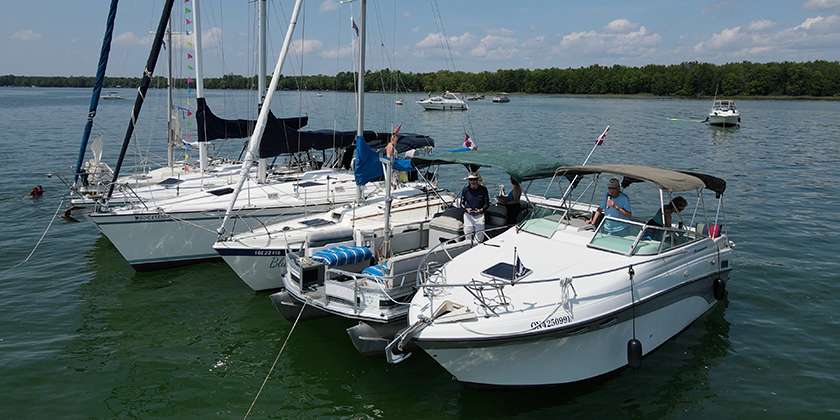
When cruising in Martinique in the Caribbean a few years ago, we rode out a tropical storm by anchoring and tying into the mangroves. Boats around us that hadn’t anchored properly were dragging through the anchorage risking damage to themselves and other boats. In several cases, we saw fellow sailors raft the drifting boats to their own securely anchored yachts to prevent disaster to the boat dragging by them and to help the crew members aboard. (We documented this on video in “Tying Your Boat in a Mangrove During a Hurricane” on the Distant Shores YouTube Channel at https://www.youtube.com/watch?v=f4PdWV9T1jI )
When transiting the Panama Canal aboard our Southerly 480, Distant Shores III, it was required that three sailboats be rafted together and positioned behind a large ship in the locks. The raft was controlled by the engine of the boat in the middle, which was our boat, plus long lines managed by shoremen on the edge of the canal to guide the raft. In this case, rafting-up was a technique used for getting small sailboats safely and efficiently through the enormous locks of the Panama Canal System. (See our “Transiting the Panama Canal System on a Sailboat” video series on the Distant Shores YouTube Channel https://youtu.be/mC7jnZ3TteU?si=WUn8xBDjwdTf5i-a )
Rafting is also used in small harbours during high season when there isn’t enough dock space for the number of visiting boats. We find this is more common in Europe where, in many cases when you call or radio ahead to check in, you are told which boat to raft to, ensuring that boats of similar size are rafted together. People there expect you to tie up against their boats since it is the norm in the summer and it’s all very friendly. We found this was the case when sailing in the Netherlands and Scandinavia and also when making landfall in Horta in the Azores in the springtime following a transatlantic passage.
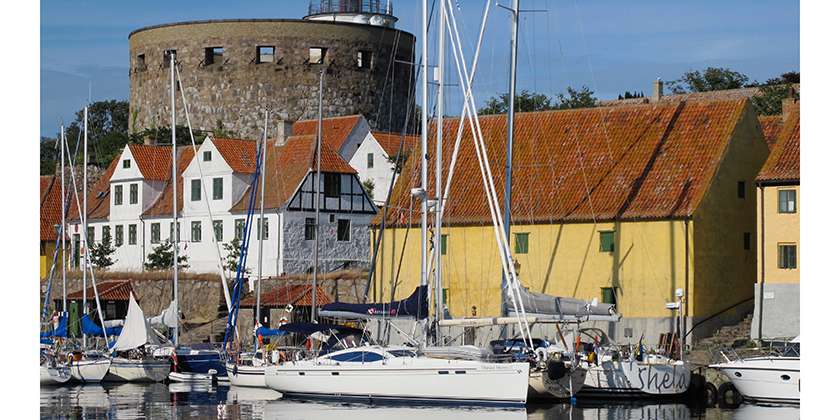
Depending on the size of the harbour or marina, you could be in a raft of 3 or 4 boats deep against a dock or town quay. We’ll talk about how to manage this in the paragraphs that follow.
Sometimes the tolerance for rafting created surprising situations. In Denmark, we entered the small harbour at the tiny island of Christiansø where they were rafting yachts out on both sides of the harbour. Boats kept coming in and the rafts continued to grow deeper and deeper, such that we thought the rafts on both sides of the harbour were going to meet in the middle! Thankfully, it never came to that, but we did start to wonder! The harbour was very secure and everyone was skilled at rafting and the etiquette involved (more on that later) so everyone had a quiet comfortable night.
So just how do you raft your boat up to another boat safely, you ask?
Rafting at Anchor
Probably the most common and enjoyable way to raft-up is at anchor so you can hang out with your friends on the water for an afternoon, so let’s start there.
First of all, choose your location. You want to form your raft in a very protected anchorage where there is no swell and few wakes from passing boats so that the boats don’t ride up and down against one another and get out of sync with the motion of the water when tied together.
For the same reason, watch the weather and only raft-up at anchor in calm quiet conditions. Steady gentle breezes are fine but if the wind is forecast to increase or switch around, which would put strain on the anchor and raft, wait for another day or be ready to un-raft and up-anchor early.
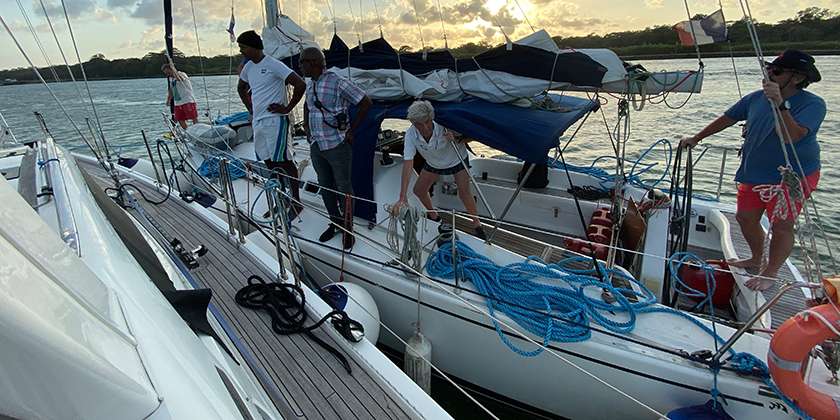
It is not recommended to raft overnight since conditions could change and put you at risk during the night. You don’t want to be untying lines and re-anchoring in the dark.
The largest heaviest boat with the biggest anchor should choose a spot to anchor that will allow space for the size of the raft and for the raft to swing if the wind shifts direction. That boat should then drop its anchor before anyone else ties up. It will then become the centre or building block for the whole raft.
When the anchor is well set, the other boats can then join one at a time on either side. Build outward from the anchored boat on both sides keeping the anchored boat in the centre and adding the largest/heaviest to smallest/lightest boats. By keeping the anchored boat in the middle of the raft, there is the least tension on the lines and the boats tend to swing less.
Each boat joining the raft should approach slowly with four dock lines ready and with fenders well positioned for the curve of the hulls that will be side by side. A general rule is to have at least one fender for every 10 feet of length overall (LOA) but the more the merrier we always figure. Also be aware of the position of flying bridges and rigging on each boat, such as shrouds, masts and spreaders, that could tangle or bang into each other if the boats are perfectly lined up, the raft gets waked and the boats start bouncing. You may need to stagger your boat’s position a bit to avoid this as you come alongside the boat you’re going to tie up to. You may also consider lining up the side gates or swim platforms of the boats so you can walk back and forth between the two easily but this isn’t always possible or practical.
As you come slowly alongside, tightly a tie bow line and stern line to the cleats of the boat you’re tying to. Don’t tie to stanchions or other deck fittings such as handrails. They won’t be strong enough. Then run a line from the bow of one boat to the stern of the other or to their mid-ships cleat. Also, run a line from the stern of one boat to the bow or mid-ships cleat of the other. These are called spring lines. This will minimize fore and aft motion. Think of creating an “X” with the lines between the two boats to prevent motion fore and aft.
Now go back and really tighten up the lines so the two boats will rise and fall together as best as possible. At all times watch that your hands and fingers don’t get pinched between the two boats.
Once secured, prepare to help the next boat come alongside you if you are adding more boats to your raft. Have fenders out on both sides of your boat.
If your raft gets so big and heavy that you fear it will be too heavy for the centre boat’s anchor to hold, you could consider having another boat in the raft put its anchor out too but only if conditions are very calm and there is lots of space in the anchorage. Otherwise, putting out a second anchor is not recommended since the raft won’t be able to swing if the wind shifts. This will create strain on the anchors and raft as well as potential collisions with other boats swinging at anchor nearby since your raft won’t be swinging in sync with two anchors out.
Once everyone is happy that all is secure, it’s time to relax and have a good time with your friends.
When you’re ready to break up the raft, repeat the procedure in reverse with one boat leaving at a time and being careful to avoid banging each other’s rigging as you leave. Always keep your hands and fingers safe.
Rafting on a Mooring
We recently spoke to friends who are wintering aboard their boat in Vero Beach, FL and are rafted to another boat on a mooring. This means their raft’s foundation is a mooring rather than one boat’s anchor. This was directed by the harbour master who knows the strength and condition of the moorings plus the harbour is very protected. The two boats swing together if the wind direction changes. This is an unusual situation. Unless you know the condition of a mooring, it is not recommended to raft-up two or more boats on a mooring.
Rafting in a Harbour Against a Dock or Quay
The next most common situation for using your rafting skills is to raft-up to another boat alongside a town quay or dock. This allows more boats to fit into a small harbour but, since you generally don’t know the people you are tying to, rafting etiquette and good manners are required.
Even if the harbour master has directed you to tie to a certain boat, it is still common courtesy to approach slowly, call to the crew on the boat you wish to tie to and request permission to come alongside. If you have fenders and lines ready, look prepared and competent, the common response is a hearty greeting and offer of assistance to help you tie alongside.
If you aren’t assigned a particular boat to tie to by the harbour master or a marina staff member, be sure to find a boat of a similar size or larger to tie against and ask permission from the crew on board.
Follow the same method of tying alongside as outlined for rafting-up at anchor, but in addition, run a bow and stern line to the quay or dock, past the inner boat(s) for extra security especially if the raft is, or is about to become, more than two boats deep.
Ask the crew of the boat you are tied to where they would like you to walk across their boat when you want to go ashore to the quay or dock. Normally this is along the side deck, up to the bow and around to the side gate on the other side, rather than through their cockpit which is an invasion of privacy. Also, ask whether they would like you to remove your shoes when on their deck.
Next, ask when they are planning to leave since they may need to leave early to catch the tide or make it to their next destination in daylight. You then must be prepared to get up and un-tie from them when they need to leave and re-tie your boat. Additionally, let them know when you plan to leave so they are prepared to help you cast off or at least know what’s happening when they hear voices and your engine starting.
While you are tied alongside, relax and enjoy your time on board but remember that you have new neighbours close by whom you don’t know, so it’s common courtesy not to play loud music, run your engine or your generator, creating noise and fumes or to use foul language.
If being rafted-up with people you don’t know sounds intimidating, let me tell you that we have met a lot of great people this way on our global adventures, some of whom we are still in touch with. All boaters have a lot in common and are generally friendly folk who love to meet other boaters and learn from them. We’ve gotten good tips on places to cruise, great restaurants and interesting sights to visit from people we’ve rafted to in ports all over the world.
So, if you haven’t raft-up yet, why not give it a try? It’s a lot of fun and a useful technique to employ in many situations. It could even be a skill that helps you out in a pinch in the future.
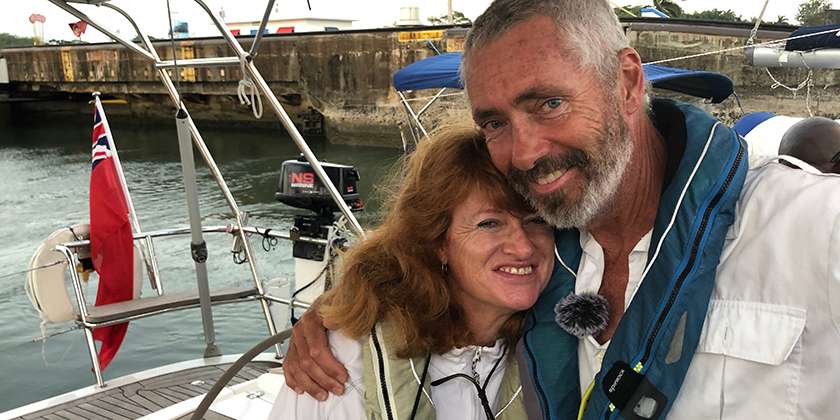
About the authors: Paul and Sheryl Shard have been sailing internationally for over 30 years including 9 ocean crossings. They are currently having a new custom aluminum Enksail Orion 49 sailboat built in the Netherlands to cruise the Arctic this summer. They are award-winning television producers, sailing authors and the fun-loving hosts of the Distant Shores sailing adventure TV series and Distant Shores YouTube Channel. @DistantShoresTV


